
![]()
~ THE ARCHBISHOPS' PALACE ~
PALACE STREET, CANTERBURY
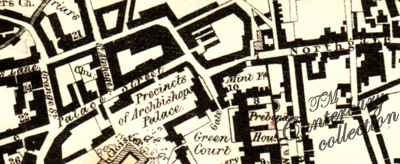
1843 detail of map from Felix Summerly's Hand-book for the city of Canterbury
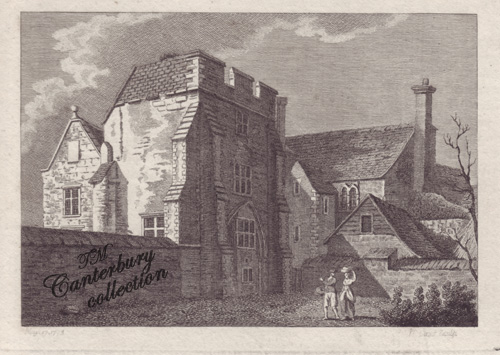
The Great Hall of the Archbishop's Palace, Canterbury May 17, 1779
"Of the Archbishop's palace in Palace street a small portion remains, and this has been incorporated in the new palace erected in the precincts, at an estimate of £18,967, from designs by Mr. W. D. Caroe, architect." 1913
To be SOLD at Canterbury in the County of
Kent, SEVERAL Leasehold Houses, called the Archbishop's Palace, situated
in the said City of Canterbury.
Also a Freehold Estate, consisting of a small Farm, called Bigberry,
and fifteen Acres of Land thereto belonging, in the Parish of Harbledown,
near Canterbury, now in the Occupation of William Kingsford, Esq; And
also about forty Acres of Wood-Land adjoining to the said Farm. For
further Particulars inquire of Mr. Parkar in Boswell-Court, London,
or of Mr. Allen and Mr. Buckwell at Canterbury. Kentish
Post September 1756 *information kindly supplied by Richard, please
do not copy the above Newspaper information without prior permission
from him - the links to his site are as follows:
http://freepages.genealogy.rootsweb.ancestry.com/~dutillieul/ZOtherPapers/NewKent11Sep1756.html (Kentish Post)
http://freepages.genealogy.rootsweb.ancestry.com/~dutillieul/ZOtherPapers/Index.html (Main Newspaper Site)
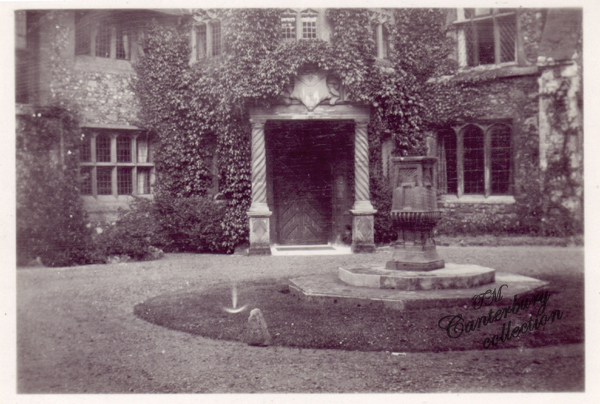
A photo of the entrance to the Archbishop's Palace in my collection c. 1935
Vincent Lade, of the Archbishop's Palace, and afterwards of Burgate, m. Ann, dau. of Kite, Esq. of Hoad House, in Bleane, and by her, who died in 1720, left, at his decease, in 1730, with other issue, who d. unm. two sons; John, the elder, b. in 1695, m. in 1723 Mary, daughter of William Frend, Gent. of Wingham, and d. in 1766, leaving two daus., Anne, m. to Isaac Ismay, of London, merchant, and Sarah, m. to Charles Topping, of London.

North-west view of Canterbury Cathedral c. 1813 (showing I believe the Archbishops Palace)
"The buildings seen in this view all belonged to the archbishop's palace. The square tower was the porch of the great Hall, and is now converted into a dwelling house; the arch of the entrance, though filled up with windows, is still apparent on the shady side of the tower.
This Hall, it is recorded, was built by archbishop Langton; the expenses of its erection, together with those of the feasting, &c. at the translation of St. Thomas Becket, laid a very heavy debt on the see, which was not cleared till the time of archbishop Boniface, the fourth in succession from Langton. The sum was twenty-five thousand marks.
The payment of this debt, according to Somner, drew from Boniface the following reflection, "My predecessors built this Hall at great expences; they "did well indeed, but they laid out no money about this building, except what they borrowed; I seem indeed to be truly the builder of this Hall, because I paid their debts."
Anno 1559, Archbishop Parker, at his consecration, found his Palace here in a very ruinous state, the great Hall in particular, partly occasioned by fire, and partly for want of the necessary repairs; he therefore, in the years 1560 and 1561, thoroughly restored the whole, expending thereon 1406l. 15s. 4d. In the year 1573, he here entertained Queen Elizabeth, and her whole Court.
This Hall was a right-angled parallelogram, its north and south sides measuring eighty three, its east and west sixty eight feet. It is now a garden, the roof, and even some of the bounding walls, being demolished; that on the east side is still standing, wherein are two Gothic canopies of Sussex marble, supported by pillars of the same, probably designed for buffets, or side boards, the tops of which growing ruinous, have been in part taken down.
Along this side runs a terrace, raised on fragments of marble pillars, piled one upon the other, like billets on a wood stack, the ends of them appeared till within a few years, when a tenant, disliking their appearance, laid a slope of green turf against them. The height of this terrace is about three feet, its breadth nearly nine; these pillars probably were ornaments to the Hall and Palace, pulled down and demolished amongst the other depredations committed by the Puritans at this place.
The north wall, now standing is modern, seemingly constructed out of the materials of the Hall, in order to enlarge the garden; the traces of the original north wall are still visible. The porch is only a square of seventeen feet.
The view above was drawn Anno 1769."
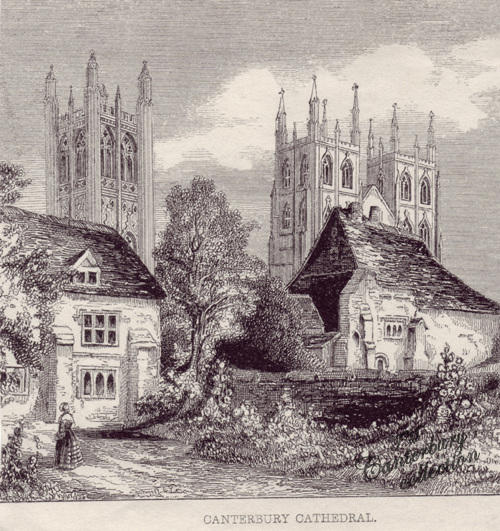
Baptism at Canterbury Cathedral
1776, April 1. Philip son of Mr. Robert Le Geyt of the Archbishops Palace & Anna Maria his wife was privately baptized April 1st received into the Congregation May 7.
Died at Canterbury, Robert Le Geyt, esq. of the archbishop's palace. - The Monthly Magazine 1798 pg. 312
Marriage at Canterbury Cathedral.
1801 April 9. Philip Le Geyt of this Parish*, Bachelor and Jane Cairnes of St. Mildreds in Canterbury, Spinster by licence. *the parish of Chislet, Kent
A report of the committee of the Canterbury Royal Lancastrian Free School, held in the Archbishop's Palace, Canterbury, represents that within the last six months 321 children had been admitted. Above 100 did not know a letter, but have learnt to read since their admission; above 250 have been taught to write; and 120 made considerable progress in arithmetic. It passes many encomiums on the master, whose instructions in the plans were received at one of Lancaster's schools, and the school itself organized by one of his boys. The same boy has organized the school near Windsor, which the royal family visited some time ago. - The Monthly Magazine 1808 (Aug 1)
Canterbury-Palace, given to the See by Archbishop Lanfranc, and afterwards rebuilt by Archbishops Hubert, Boniface, Langton and Parker, was destroyed in the time of the usurpation.
So that the Archbishops have now no Palace or House remaining in their own Diocese, and only Lambeth and Croydon out of it, both of which are in the Diocese of Winchester. 1770, Nov.
A selection of curious articles from the Gentlemen's Magazine 1811
"The palace, which was the favourite residence of many of the Archbishops of Canterbury, is a subject of particular interest. Since it was deserted and condemned by Archbishop Cornwallis, the premises have been converted into a manufactory. However, the Great Hall, and some other remarkable features, still remain; though another change is now in progress, for, in consequence of the estate having been sold in lots during the last year, various portions have lately been converted into modern dwellings, with an attendant destruction of the ancient parts."
The Gentlemen's Magazine Jan-June 1834
1840's - Sir Robert Barlow Knt. (83) Admiral R.N. (Royal Navy) with Elizabeth Barlow age 45, Maria Barlow age 30 and Charles Barlow age 23, none of whom were born in Kent.
"Died May 1843, At the Archbishop's Palace, Canterbury in his 86th year, Sir Robert Barlow*, knt., and K.C.B., Admiral of the Red, F.R.S.; father-in-law of Viscount Torrington, and of the first Earl Nelson. He was born in London on Christmas Day, 1757, the eldest son of William Barlow, of Bath, esq., by Hilare, daughter of Robert Butcher, of Walthamstow, esq. His younger brother, Sir George Hilary Barlow, G.C.B. formerly Governor-General of India, was created a Baronet June 29, 1803. Mr. Barlow served with Earl Howe and Lord Mulgrave during the whole of the American war. He was promoted to the rank of Lieutenant Nov. 6, 1778. He was Lieutenant of the Courageux at the relief of Gibraltar in 1782, and ably distinguished himself on the 18th September in that year, when the Spaniards were defeated in their grand attack on that fortress. He was made Commander Nov. 22, 1790, and Post Captain May 24, 1793. In 1794 he commanded the Pegasus, which was repeating frigate at Lord Howe's glorious victory of the French fleet on the 1st of June. He was subsequently appointed to the command of the Phoebe, 36, in which, after a severe action, he captured the French frigate Nereide in 1797; and in the same ship, in February 1801, he succeeded, after a most determined and gallant resistance, in capturing L'Africaine, 44, having on board, beyond her crew, 400 troops, under the command of General Desfourneaux, which were destined to join the French army in Egypt. It was one of the sharpest contests recorded in our naval history, as both vessels were within pistol shot, the action lasting two hours. In consideration of his bravery and gallantry on this occasion, Captain Barlow received the honour of knighthood, on the 16th June, 1801. In 1806 he was appointed Deputy Comptroller of the Navy; and in 1808, Commissioner of Chatham dockyard. In Jan. 1823, he resigned that office, with the rank of retired Rear-Admiral; but in 1840 was recalled to active duty and made Admiral of the White. On the 20th of May 1820, he was appointed a Knight Commander of the Bath. He married Sept. 8, 1785, Elizabeth, second daughter of William Garrett of Worting, in Hampshire Esq., and by that lady had issue three sons and five daughters."
The Annual Register 1843
*There was an oil Portrait of Sir Robert Barlow that was sold at Christie's in 2000
Sir Robert Barlow (Commissioned Sea Officers of the Royal Navy 1660-1815)
L - November 6, 1778
CR - November 22, 1790
CA - May 24, 1793
Ret. 1810
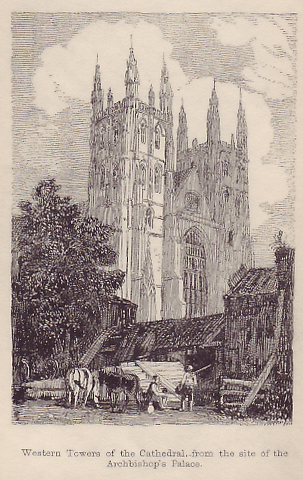
"Archbishop's Palace, which is partly a dwelling-house and partly a carpenter's workshop. There is a room, called, I think, "Becket's Library," in which the Tudor paneling is tolerably perfect. All the existing ruins of the palace, so far as I had an opportunity of examining them, make its age to be not later than the sixteenth century. The palace formerly extended to the end of Northgate Street, and a part of it, in a southern direction, was joined to the old Arundel steeple, but this latter part was removed when the new north-west tower was erected in 1834 by Mr. George Austin. Anterior to Lanfranc's time, it would appear that there was no dwelling for the Archbishop apart from the rest of the Monastery, but that he resided in common with the general establishment.
The Hall of the Palace, which was standing until late years, was founded by Archbishop Langton, who ran into much debt on account of it and other extravagances. One of his successors, Archbishop Boniface, is recorded to have said when he paid off the debts, "My predecessors built this hall at great expenses; they did well indeed, but they laid out no money about this building, except what they borrowed. I seem indeed, to be truly the builder of this hall, because I paid their debts." Archbishop Parker, too, added much to this Palace, but his buildings have been lately removed, and the materials of them reconstructed into the surveyor's residence, situate opposite the south end of Northgate Street, as nearly as possible after the original model. The arms of the Archbishop may still be seen over the garden entrance to the house. Some few years ago, a few old and mean houses adjoined the buildings of the Palace in front of the west end of the Cathedral. One of these was a barber's shop, with its pole out at the door, kept by the father of the late Lord Tenterden, formerly Lord Chief Justice Abbot; and the Chief Justice himself was born there. After his elevation to the Peerage he was accustomed often to say, with a truly noble pride, pointing to the identical little shop - "Here my father used to shave for a penny. It has been the pride of my life never to forget it."
Felix Summerly 1843 / Canterbury in the Olden Time John Brent
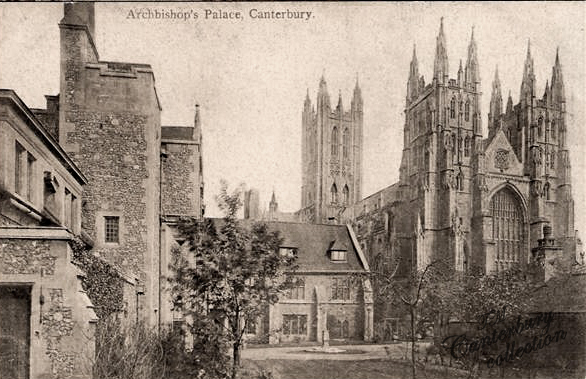
"Archbishop's Palace" my old postcard
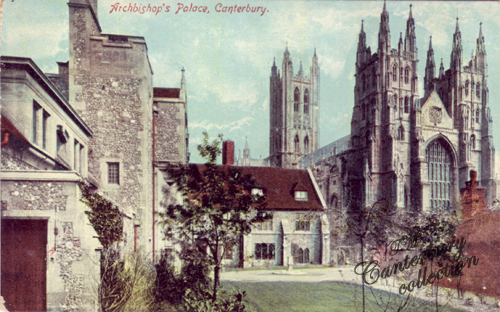
"Archbishop's Palace" my old postcard
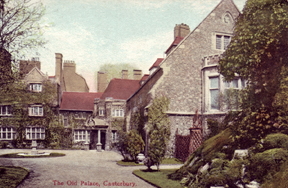
"Death January 28th, at Ringwould rectory, aged 80, Sarah, relict of John Monins, esq., of the Archbishop's Palace, Canterbury." The Gentlemen's Magazine 1845
"The ancient buildings of Ethelbert's Palace, in all probability, was consumed in the same flames that destroyed both the church and the city in the year 1011. Whatever Lanfranc built of his palace, there seems to be very little, if any part of it left. Archbishop Hubert, who came to the see about one hundred years after Lanfranc's death, found this palace in a state of decay, pulled down the greatest part of it, and afterwards laid the foundation s of that large and stately hall, and other suitable offices, almost the whole of which remained till the rebellion in the middle of the last century. Archbishop Langton, Hubert's successor, carried the building on , and having completed it, gained the credit of being the founder of it; yet the beautifying and adorning of it was left to Archbishop Boniface, who, as he himself expresses it, might truly be accounted the founder of it, by paying these debts which his predecessors had contracted for the expenses of it. In this grand and stately palace, royal guests were frequently and magnificently entertained, and there the Archbishops had their splendid feast on the day of their inthronization.
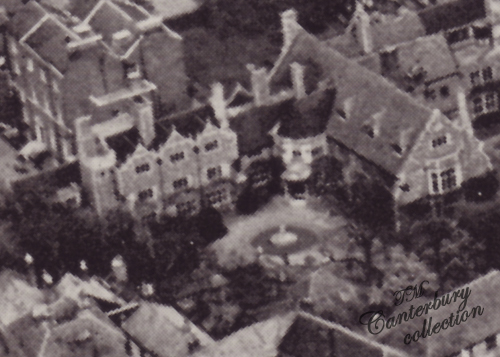
...this palace suffered greatly by fire, and continued in this ruinated state at the time of Archbishop Parker's coming to the see in the first year of Queen Elizabeth, and he in the next two years expended upwards of 1,400 pounds in the re-edifying of it; after which that Queen being here on one of her progresses through the county, the Archbishop made a sumptuous banquet at this palace, to which he invited the Queen and a great number of noblemen. In this state the palace remained till the abolition of Episcopacy and Church Government, after the death of Charles I., when the whole of it was sold to supply the necessities of the state. The purchaser pulled down the great hall and other best apartments, and sold the materials, and converted the remainder into private houses, in which state it has continued ever since. On the restoration of Charles II., the remains of the palace, with the precincts of it, returned to the see of Canterbury; but the Archbishop, on taking possession of them, found the state of the buildings to be such, as not to be capable of being habitable for him. He demised the whole of the site, with the buildings and precincts of it, on a beneficial lease to one lessee for thirty years, renewable every ten years, on paying an adequate fine. The lessee built himself a good brick residence on part of the premises."
Directory 1847
"Of the Archbishop's sumptuous palace in Palace-street, only the wall and an archway remain, and the Archbishops have been long non-resident. This too forms a precinct."
1858 Directory, Melville & Co.
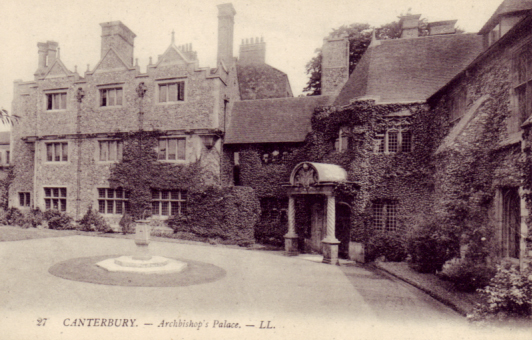
"Archbishop's Palace" my old postcard
"The Archbishop's palace, founded in the time of the Saxons, rebuilt by Lanfranc and extended by Hubert Walter and Stephen Langton, stood in Palace-street; but is now represented by little else than an arched doorway. This was the scene of the death of the Black Prince; of the prelude of the murder of Thomas a Becket; of the bridal feast of Edward I.; and of banquets to Henry VIII., Charles V., and Elizabeth."
The Imperial Gazetteer of England and Wales, Vol. I. 1872
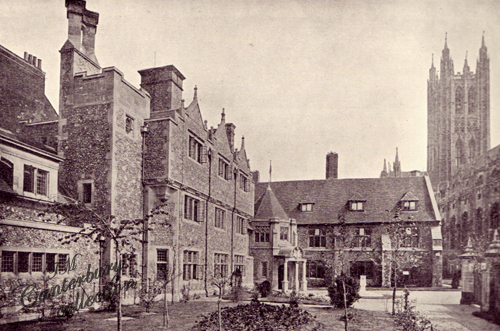
The Archbishops Palace c. 1902

In Palace Street (entered by the Porter's Gate) is an arched doorway, all that is left of the Archbishops Palace, once famous for its hospitalities and for the royal and distinguished guests that were entertained here. Having examined the Cathedral and the remains of the Christ Church Priory, the tourist should visit the monastery of St. Augustine, now incorporated with St. Augustine's College (no admission until late afternoon). Handbook of the County of Kent 1878